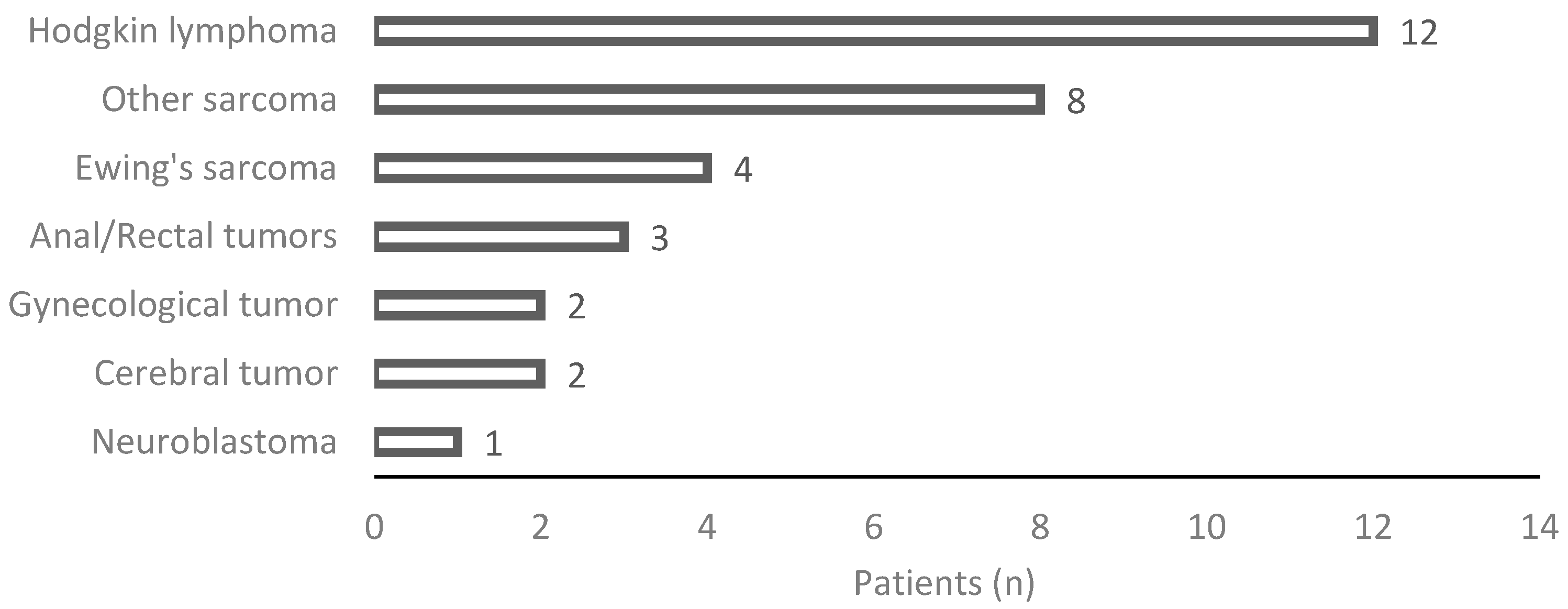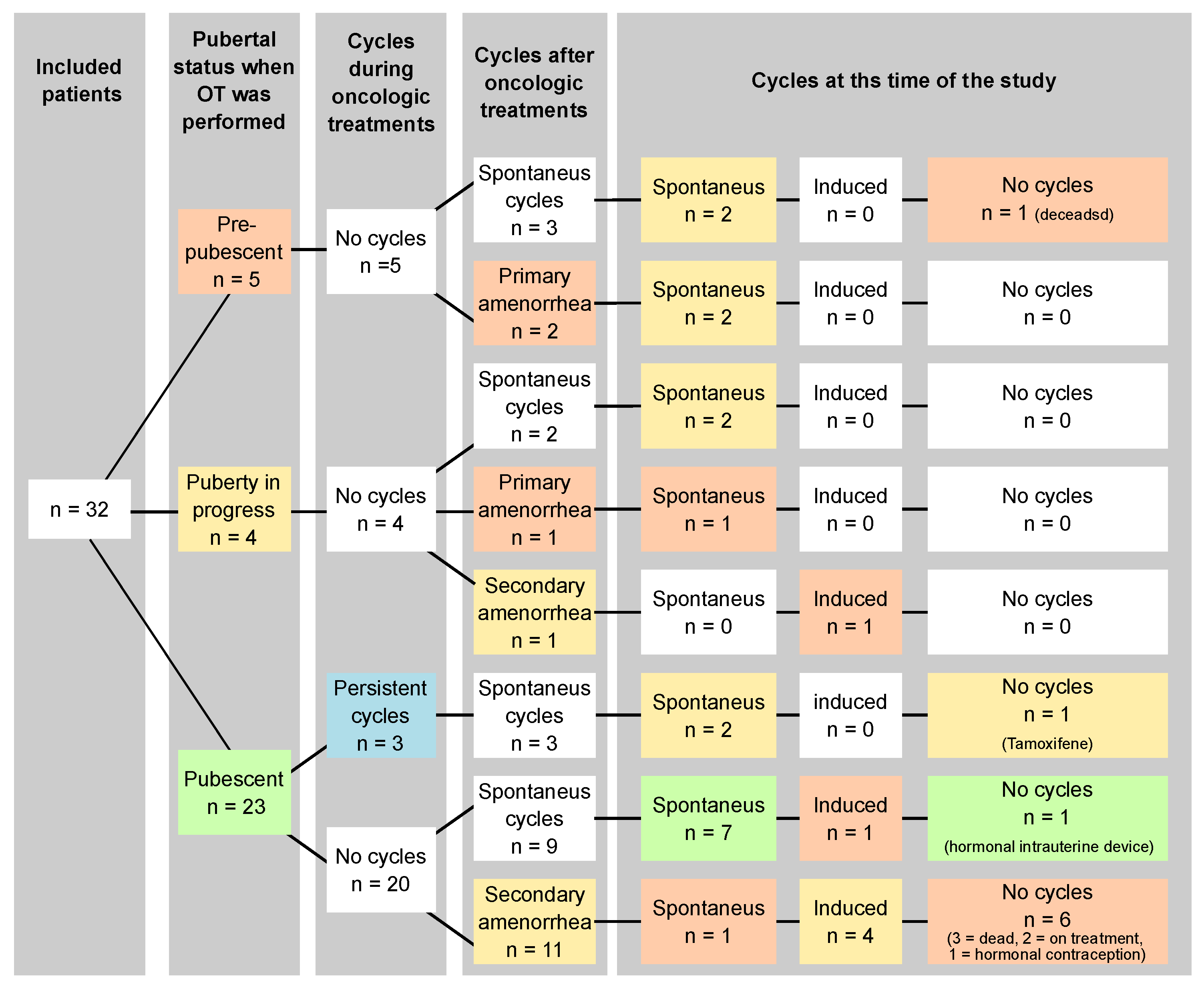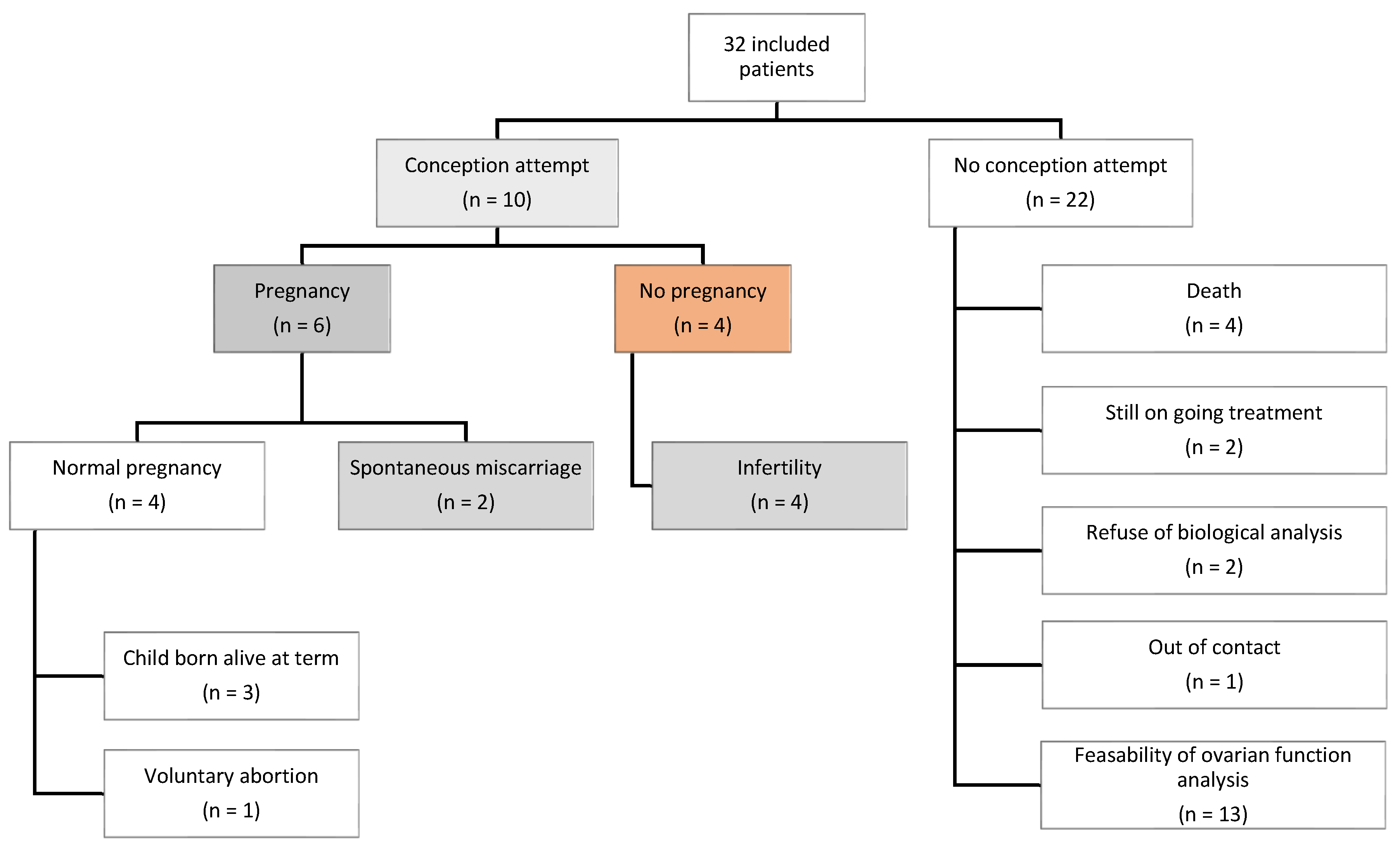Fertility Assessment after Ovarian Transposition in Children and Young Women Treated for a Malignant Tumor
Abstract
1. Introduction
2. Materials and Methods
2.1. Patients and Inclusion Criteria—Data Collection
2.2. Cancer Treatment and Disease Follow-Up
2.3. Fertility Preservation
2.4. Assessment of Fertility and Ovarian Function
2.5. Statistical Analysis
2.6. Ethical Approval and Consent
3. Results
3.1. Population
3.2. Cancer Treatment
3.2.1. Fertility Preservation
3.2.2. Pubertal Development and Ovarian Function (Menstrual Cycles)
3.2.3. Fertility
4. Discussion
5. Conclusions
Author Contributions
Funding
Institutional Review Board Statement
Informed Consent Statement
Data Availability Statement
Acknowledgments
Conflicts of Interest
References
- L’Institut National du Cancer (INCa). Les Cancers En France—Edition 2015; Institut National du Cancer: Boulogne-Billancourt, France, 2015. [Google Scholar]
- Desandes, E.; Lacour, B.; Belot, A.; Molinie, F.; Delafosse, P.; Tretarre, B.; Velten, M.; Sauleau, E.-A.; Woronoff, A.-S.; Guizard, A.-V.; et al. Cancer Incidence and Survival in Adolescents and Young Adults in France, 2000–2008. Pediatr. Hematol. Oncol. 2013, 30, 291–306. [Google Scholar] [CrossRef] [PubMed]
- Brougham, M.F.H.; Wallace, W.H.B. Subfertility in Children and Young People Treated for Solid and Haematological Malignancies. Br. J. Haematol. 2005, 131, 143–155. [Google Scholar] [CrossRef] [PubMed]
- Légifrance LOI N° 2011–814 du 7 Juillet 2011 Relative à La Bioéthique. Available online: https://www.legifrance.gouv.fr/loda/id/JORFTEXT000024323102 (accessed on 27 May 2024).
- Lambertini, M.; Del Mastro, L.; Pescio, M.C.; Andersen, C.Y.; Azim, H.A.; Peccatori, F.A.; Costa, M.; Revelli, A.; Salvagno, F.; Gennari, A.; et al. Cancer and Fertility Preservation: International Recommendations from an Expert Meeting. BMC Med. 2016, 14, 1. [Google Scholar] [CrossRef] [PubMed]
- Oktay, K.; Harvey, B.E.; Partridge, A.H.; Quinn, G.P.; Reinecke, J.; Taylor, H.S.; Wallace, W.H.; Wang, E.T.; Loren, A.W. Fertility Preservation in Patients with Cancer: ASCO Clinical Practice Guideline Update. J. Clin. Oncol. 2018, 36, 1994–2001. [Google Scholar] [CrossRef] [PubMed]
- McCALL, M.L.; Keaty, E.C.; Thompson, J.D. Conservation of Ovarian Tissue in the Treatment of Carcinoma of the Cervix with Radical Surgery. Am. J. Obstet. Gynecol. 1958, 75, 590–600; discussion 600–605. [Google Scholar] [CrossRef] [PubMed]
- Meirow, D.; Biederman, H.; Anderson, R.A.; Wallace, W.H.B. Toxicity of Chemotherapy and Radiation on Female Reproduction. Clin. Obstet. Gynecol. 2010, 53, 727–739. [Google Scholar] [CrossRef] [PubMed]
- Wallace, W.H.B.; Thomson, A.B.; Kelsey, T.W. The Radiosensitivity of the Human Oocyte. Hum. Reprod. 2003, 18, 117–121. [Google Scholar] [CrossRef] [PubMed]
- Thibaud, E.; Ramirez, M.; Brauner, R.; Flamant, F.; Zucker, J.M.; Fékété, C.; Rappaport, R. Preservation of Ovarian Function by Ovarian Transposition Performed before Pelvic Irradiation during Childhood. J. Pediatr. 1992, 121, 880–884. [Google Scholar] [CrossRef] [PubMed]
- Chemaitilly, W.; Sklar, C.A. Endocrine Complications in Long-Term Survivors of Childhood Cancers. Endocr. Relat. Cancer 2010, 17, R141–R159. [Google Scholar] [CrossRef] [PubMed]
- Irtan, S.; Orbach, D.; Helfre, S.; Sarnacki, S. Ovarian Transposition in Prepubescent and Adolescent Girls with Cancer. Lancet Oncol. 2013, 14, e601–e608. [Google Scholar] [CrossRef] [PubMed]
- Mossa, B.; Schimberni, M.; Di Benedetto, L.; Mossa, S. Ovarian Transposition in Young Women and Fertility Sparing. Eur. Rev. Med. Pharmacol. Sci. 2015, 19, 3418–3425. [Google Scholar] [PubMed]
- Cowles, R.A.; Gewanter, R.M.; Kandel, J.J. Ovarian Repositioning in Pediatric Cancer Patients: Flexible Techniques Accommodate Pelvic Radiation Fields. Pediatr. Blood Cancer 2007, 49, 339–341. [Google Scholar] [CrossRef] [PubMed]
- Meirow, D.; Nugent, D. The Effects of Radiotherapy and Chemotherapy on Female Reproduction. Hum. Reprod. Update 2001, 7, 535–543. [Google Scholar] [CrossRef] [PubMed]
- Levy, M.J.; Stillman, R.J. Reproductive Potential in Survivors of Childhood Malignancy. Pediatrician 1991, 18, 61–70. [Google Scholar] [PubMed]
- Terenziani, M.; Piva, L.; Meazza, C.; Gandola, L.; Cefalo, G.; Merola, M. Oophoropexy: A Relevant Role in Preservation of Ovarian Function after Pelvic Irradiation. Fertil. Steril. 2009, 91, 935.e15–935.e16. [Google Scholar] [CrossRef] [PubMed]
- Anderson, R.A.; McLaughlin, M.; Wallace, W.H.B.; Albertini, D.F.; Telfer, E.E. The Immature Human Ovary Shows Loss of Abnormal Follicles and Increasing Follicle Developmental Competence through Childhood and Adolescence. Hum. Reprod. 2014, 29, 97–106. [Google Scholar] [CrossRef] [PubMed]
- Morice, P.; Castaigne, D.; Haie-Meder, C.; Pautier, P.; El Hassan, J.; Duvillard, P.; Gerbaulet, A.; Michel, G. Laparoscopic Ovarian Transposition for Pelvic Malignancies: Indications and Functional Outcomes. Fertil. Steril. 1998, 70, 956–960. [Google Scholar] [CrossRef] [PubMed]
- Morice, P.; Thiam-Ba, R.; Castaigne, D.; Haie-Meder, C.; Gerbaulet, A.; Pautier, P.; Duvillard, P.; Michel, G. Fertility Results after Ovarian Transposition for Pelvic Malignancies Treated by External Irradiation or Brachytherapy. Hum. Reprod. 1998, 13, 660–663. [Google Scholar] [CrossRef] [PubMed]
- Zinger, M.; Liu, J.H.; Husseinzadeh, N.; Thomas, M.A. Successful Surrogate Pregnancy after Ovarian Transposition, Pelvic Irradiation and Hysterectomy. J. Reprod. Med. 2004, 49, 573–574. [Google Scholar] [PubMed]
- Anderson, R.A.; Wallace, W.H.B.; Baird, D.T. Ovarian Cryopreservation for Fertility Preservation: Indications and Outcomes. Reproduction 2008, 136, 681–689. [Google Scholar] [CrossRef]
- Damewood, M.D.; Hesla, H.S.; Lowen, M.; Schultz, M.J. Induction of Ovulation and Pregnancy Following Lateral Oophoropexy for Hodgkin’s Disease. Int. J. Gynaecol. Obstet. 1990, 33, 369–371. [Google Scholar] [CrossRef] [PubMed]
- Howard, F.M. Laparoscopic Lateral Ovarian Transposition before Radiation Treatment of Hodgkin Disease. J. Am. Assoc. Gynecol. Laparosc. 1997, 4, 601–604. [Google Scholar] [CrossRef] [PubMed]
- Huang, K.-G.; Lee, C.-L.; Tsai, C.-S.; Han, C.-M.; Hwang, L.-L. A New Approach for Laparoscopic Ovarian Transposition before Pelvic Irradiation. Gynecol. Oncol. 2007, 105, 234–237. [Google Scholar] [CrossRef] [PubMed]
- Gabriel, D.A.; Bernard, S.A.; Lambert, J.; Croom, R.D. Oophoropexy and the Management of Hodgkin’s Disease. A Reevaluation of the Risks and Benefits. Arch. Surg. 1986, 121, 1083–1085. [Google Scholar] [CrossRef]
- Barahmeh, S.; Al Masri, M.; Badran, O.; Masarweh, M.; El-Ghanem, M.; Jaradat, I.; Lataifeh, I. Ovarian Transposition before Pelvic Irradiation: Indications and Functional Outcome. J. Obstet. Gynaecol. Res. 2013, 39, 1533–1537. [Google Scholar] [CrossRef] [PubMed]
- Demeestere, I.; Brice, P.; Peccatori, F.A.; Kentos, A.; Dupuis, J.; Zachee, P.; Casasnovas, O.; Van Den Neste, E.; Dechene, J.; De Maertelaer, V.; et al. No Evidence for the Benefit of Gonadotropin-Releasing Hormone Agonist in Preserving Ovarian Function and Fertility in Lymphoma Survivors Treated with Chemotherapy: Final Long-Term Report of a Prospective Randomized Trial. J. Clin. Oncol. 2016, 34, 2568–2574. [Google Scholar] [CrossRef] [PubMed]
- Lee, S.J.; Schover, L.R.; Partridge, A.H.; Patrizio, P.; Wallace, W.H.; Hagerty, K.; Beck, L.N.; Brennan, L.V.; Oktay, K. American Society of Clinical Oncology American Society of Clinical Oncology Recommendations on Fertility Preservation in Cancer Patients. J. Clin. Oncol. 2006, 24, 2917–2931. [Google Scholar] [CrossRef] [PubMed]
- Fraison, E.; Huberlant, S.; Labrune, E.; Cavalieri, M.; Montagut, M.; Brugnon, F.; Courbiere, B. Live Birth Rate after Female Fertility Preservation for Cancer or Haematopoietic Stem Cell Transplantation: A Systematic Review and Meta-Analysis of the Three Main Techniques; Embryo, Oocyte and Ovarian Tissue Cryopreservation. Hum. Reprod. 2023, 38, 489–502. [Google Scholar] [CrossRef] [PubMed]
- Dolmans, M.-M.; von Wolff, M.; Poirot, C.; Diaz-Garcia, C.; Cacciottola, L.; Boissel, N.; Liebenthron, J.; Pellicer, A.; Donnez, J.; Andersen, C.Y. Transplantation of Cryopreserved Ovarian Tissue in a Series of 285 Women: A Review of Five Leading European Centers. Fertil. Steril. 2021, 115, 1102–1115. [Google Scholar] [CrossRef] [PubMed]
- Hambridge, H.L.; Mumford, S.L.; Mattison, D.R.; Ye, A.; Pollack, A.Z.; Bloom, M.S.; Mendola, P.; Lynch, K.L.; Wactawski-Wende, J.; Schisterman, E.F. The Influence of Sporadic Anovulation on Hormone Levels in Ovulatory Cycles. Hum. Reprod. 2013, 28, 1687–1694. [Google Scholar] [CrossRef]






| Treatment | n (%) | Mean | SD | 95% CI | Median | Min 1 | Max 1 |
|---|---|---|---|---|---|---|---|
| Chemotherapy (cumulated doses) | 28 (88%) | ||||||
| Busulfan (mg/m2) | 3 (9%) | 429 | 321 | [66–793] | 247 | 241 | 800 |
| Melphalan (mg/m2) | 5 (16%) | 716 | 498 | [152–1280] | 1000 | 140 | 1007 |
| Ifosfamide (g/m2) | 15 (47%) | 41 | 24 | [29–53] | 45 | 7 | 95 |
| Cyclophosphamide (mg/m2) | 19 (59%) | 4721 | 3249 | [3220–6222] | 3946 | 554 | 11,863 |
| Procarbazine (mg/m2) | 9 (28%) | 6315 | 3674 | [3769–8860] | 8959 | 2094 | 9028 |
| Dacarbazine (mg/m2) | 6 (19%) | 2968 | 1917 | [1434–4501] | 2849 | 747 | 5425 |
| Radiotherapy | 30 (94%) | ||||||
| Total dose (planning target volume) (Gy) | - | 36 | 16.5 | [30.3–41.7] | 36 | 19.8 | 60 |
| <20 Gy | 1 (3%) | - | - | - | - | - | - |
| >20 Gy | 29 (97%) | - | - | - | - | - | - |
| Number of fractions | - | 20 | 9 | [17–23] | 20 | 5 | 36 |
| Duration | - | 33 | 15 | [28–38] | 36 | 11 | 65 |
| Mean dose 2 to ovaries (Gy) | - | 3.3 | 7.4 | [0.7–5.8] | 1 | 0 | 36 |
| Maximal dose 3 to ovaries (Gy) | - | 3.6 | 7.6 | [0.7–6.5] | 2 | 0 | 36 |
| <3 Gy | 12 (38%) | - | - | - | - | - | - |
| 3–10 Gy | 7 (22%) | - | - | - | - | - | - |
| 10–20 Gy | 5 (16%) | - | - | - | - | - | - |
| >20 Gy | 8 (25%) | - | - | - | - | - | - |
| Mean dose 2 to uterus (Gy) | - | 14.3 | 14.2 | [6.5–22.0] | 20 | 0 | 45 |
| Maximal dose 3 to uterus (Gy) | - | 20.9 | 17.4 | [13.1–28.7] | 20 | 0 | 54 |
| Timing | Complications | Grading | Consequences |
|---|---|---|---|
| Per-operative | Hematoma retro-peritoneal | Grade 3 | Per-operative evacuation |
| Peritoneal adhesions | Grade 3 | Conversion to laparotomy | |
| Ischemia of fallopian tube | Grade 3 | Homolateral salpingectomy | |
| Post-operative | Bladder injury with dysuria | Grade 3 | Bladder suturing |
| Chronic abdominal pain | Grade 2–3 | Reduction of quality of life |
Disclaimer/Publisher’s Note: The statements, opinions and data contained in all publications are solely those of the individual author(s) and contributor(s) and not of MDPI and/or the editor(s). MDPI and/or the editor(s) disclaim responsibility for any injury to people or property resulting from any ideas, methods, instructions or products referred to in the content. |
© 2024 by the authors. Licensee MDPI, Basel, Switzerland. This article is an open access article distributed under the terms and conditions of the Creative Commons Attribution (CC BY) license (https://creativecommons.org/licenses/by/4.0/).
Share and Cite
Valduga, J.; Desmules, G.; Claude, L.; Chastagner, P.; Bernier-Chastagner, V.; Marec-Berard, P.; Rousset-Jablonski, C. Fertility Assessment after Ovarian Transposition in Children and Young Women Treated for a Malignant Tumor. Curr. Oncol. 2024, 31, 3177-3188. https://doi.org/10.3390/curroncol31060240
Valduga J, Desmules G, Claude L, Chastagner P, Bernier-Chastagner V, Marec-Berard P, Rousset-Jablonski C. Fertility Assessment after Ovarian Transposition in Children and Young Women Treated for a Malignant Tumor. Current Oncology. 2024; 31(6):3177-3188. https://doi.org/10.3390/curroncol31060240
Chicago/Turabian StyleValduga, Julie, Géraldine Desmules, Line Claude, Pascal Chastagner, Valérie Bernier-Chastagner, Perrine Marec-Berard, and Christine Rousset-Jablonski. 2024. "Fertility Assessment after Ovarian Transposition in Children and Young Women Treated for a Malignant Tumor" Current Oncology 31, no. 6: 3177-3188. https://doi.org/10.3390/curroncol31060240
APA StyleValduga, J., Desmules, G., Claude, L., Chastagner, P., Bernier-Chastagner, V., Marec-Berard, P., & Rousset-Jablonski, C. (2024). Fertility Assessment after Ovarian Transposition in Children and Young Women Treated for a Malignant Tumor. Current Oncology, 31(6), 3177-3188. https://doi.org/10.3390/curroncol31060240





